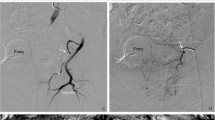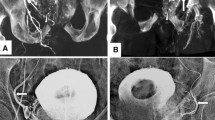Abstract
Objectives
To evaluate the benefits of repeat prostatic artery embolization (rePAE) for patients with persistent or recurrent symptoms after initial prostatic artery embolization (PAE).
Materials and Methods
This is a single-center retrospective study of all patients who underwent a rePAE between December 2014 and November 2020 for persistent or recurrent lower urinary tract symptoms. Symptoms were assessed before and after PAE and rePAE, using the International Prostate Symptom Score and quality of life (QoL) questionnaires. Patient characteristics, anatomical presentations, technical success rates, and complications of both procedures were collected. Clinical failure was defined as one of the following: less than 2 points’ decrease in QoL, a QoL score higher than 3, acute urinary retention, and secondary surgery.
Results
A total of 21 consecutive patients (mean age: 63.8 ± 8.1; [40–75] years) who underwent rePAE were included. The median follow-up after PAE was 27.7 [18.1–36.9]) months and 8.9 [3.4–10.8] months after rePAE. rePAE was performed at a mean of 19 ± 11.1 [6.9–49.6] months following PAE, and the overall clinical success rate was 33% (7/21). In patients undergoing rePAE because of persistent symptoms, the clinical success rate (18%) was non-significantly lower than that for patients treated for recurrent symptoms (50%) [OR 4.5 (95% CI 0.63–32 P = 0.13)]. The main anatomical revascularization pattern was recanalization of the native prostatic artery (29/45, 66%).
Conclusion
Patients who experience recurrent symptoms after PAE may benefit more from rePAE than those with persistent symptoms after PAE. Clinical success rates seem to be relatively low in both clinical scenarios.



Similar content being viewed by others
Abbreviations
- BPH:
-
Benign prostatic hyperplasia
- DSA:
-
Digital subtraction angiography
- CBCT:
-
Cone-beam computed tomography
- IIEF:
-
International Index of Erectile Function
- IPP:
-
Intravesical prostatic protrusion
- IPSS:
-
International Prostate Symptom Score
- PA:
-
Prostatic artery
- PAE:
-
Prostatic artery embolization
- PVR:
-
Post-void residual
- Qmax:
-
Maximum flow rate
- QoL:
-
Quality of life
- rePAE:
-
Repeat prostatic artery embolization
- TURP:
-
Transurethral resection of the prostate
References
Malling B, Røder MA, Brasso K, et al. Prostate artery embolisation for benign prostatic hyperplasia: a systematic review and meta-analysis. Eur Radiol. 2019;29:287–98. https://doi.org/10.1007/s00330-018-5564-2.
Ray AF, Powell J, Speakman MJ, et al. Efficacy and safety of prostate artery embolization for benign prostatic hyperplasia: an observational study and propensity-matched comparison with transurethral resection of the prostate (the UK-ROPE study). BJU Int. 2018;122:270–82. https://doi.org/10.1111/bju.14249.
Abt D, Hechelhammer L, Müllhaupt G, et al. Comparison of prostatic artery embolisation (PAE) versus transurethral resection of the prostate (TURP) for benign prostatic hyperplasia: randomised, open label, non-inferiority trial. BMJ. 2018. https://doi.org/10.1136/bmj.k2338.
Bilhim T, Costa NV, Torres D, et al. Long-term outcome of prostatic artery embolization for patients with benign prostatic hyperplasia: single-centre retrospective study in 1072 patients over a 10-year period. Cardiovasc Intervent Radiol. 2022;45:1324–36. https://doi.org/10.1007/s00270-022-03199-8.
Carnevale FC, Moreira AM, de Assis AM, et al. Prostatic artery embolization for the treatment of lower urinary tract symptoms due to benign prostatic hyperplasia: 10 years’ experience. Radiology. 2020;296:444–51. https://doi.org/10.1148/radiol.2020191249.
Bilhim T, Pisco J, Pereira JA, et al. Predictors of clinical outcome after prostate artery embolization with spherical and nonspherical polyvinyl alcohol particles in patients with benign prostatic hyperplasia. Radiology. 2016;281:289–300. https://doi.org/10.1148/radiol.2016152292.
Sun F, Lucas-Cava V, Sánchez-Margallo FM. Clinical predictive factors in prostatic artery embolization for symptomatic benign prostatic hyperplasia: a comprehensive review. Transl Androl Urol. 2020;9(4):1754–68. https://doi.org/10.21037/tau-20-437.
Boeken T, Di Gaeta A, Moussa N, et al. Association between intravesical prostatic protrusion and clinical outcomes in prostatic artery embolization. Diagn Interv Imaging. 2021;102:141–5. https://doi.org/10.1016/j.diii.2020.12.003.
Xu Z-W, Zhou C-G, Tian W, et al. Long-term efficacy and recurrence prediction of prostatic artery embolization for lower urinary tract symptoms secondary to benign prostatic hyperplasia. Cardiovasc Intervent Radiol. 2022;45:1801–9. https://doi.org/10.1007/s00270-022-03272-2.
Kenny AG, Pellerin O, Moussa N, et al. Repeat prostatic artery embolization. J Vasc Interv Radiol. 2020;31:1090-1095.e1. https://doi.org/10.1016/j.jvir.2020.03.012.
de Assis AM, Moreira AM, Carnevale FC. Angiographic findings during repeat prostatic artery embolization. J Vasc Interv Radiol. 2019;30:645–51. https://doi.org/10.1016/j.jvir.2018.12.734.
Costa NV, Torres D, Pisco J, et al. Repeat prostatic artery embolization for patients with benign prostatic hyperplasia. J Vasc Interv Radiol. 2020;31:1272–80. https://doi.org/10.1016/j.jvir.2020.04.027.
Filippiadis DK, Binkert C, Pellerin O, et al. Cirse quality assurance document and standards for classification of complications: the Cirse classification system. Cardiovasc Intervent Radiol. 2017;40:1141–6. https://doi.org/10.1007/s00270-017-1703-4.
Cornelis FH, Bilhim T, Hacking N, et al. CIRSE standards of practice on prostatic artery embolisation. Cardiovasc Intervent Radiol. 2020;43:176–85. https://doi.org/10.1007/s00270-019-02379-3.
Amouyal G, Thiounn N, Pellerin O, et al. Clinical results after prostatic artery embolization using the PErFecTED technique: a single-center study. Cardiovasc Intervent Radiol. 2016;39:367–75. https://doi.org/10.1007/s00270-015-1267-0.
Amouyal G, Pellerin O, Del Giudice C, et al. Variants of patterns of intra- and extra-prostatic arterial distribution of the prostatic artery applied to prostatic artery embolization: proposal of a classification. Cardiovasc Intervent Radiol. 2018;41:1664–73. https://doi.org/10.1007/s00270-018-2064-3.
de Assis AM, Moreira AM, de Paula Rodrigues VC, et al. Pelvic Arterial anatomy relevant to prostatic artery embolisation and proposal for angiographic classification. Cardiovasc Intervent Radiol. 2015;38:855–61. https://doi.org/10.1007/s00270-015-1114-3.
Barat M, Jannot A-S, Dohan A, Soyer P. How to report and compare quantitative variables in a radiology article. Diagn Interv Imaging. 2022;103:571–3. https://doi.org/10.1016/j.diii.2022.09.007.
McWilliams JP, Bilhim TA, Carnevale FC, et al. Society of interventional radiology multisociety consensus position statement on prostatic artery embolization for treatment of lower urinary tract symptoms attributed to benign prostatic hyperplasia: from the society of interventional radiology, the cardiovascular and interventional radiological society of Europe, Société Française de Radiologie, and the British Society of Interventional Radiology. J Vasc Interv Radiol. 2019;30:627-637.e1. https://doi.org/10.1016/j.jvir.2019.02.013.
Kearns DJ, Boardman P, Tapping CR. Patterns of reperfusion and clinical findings in repeat prostate artery embolisation for recurrent lower urinary tract symptoms in patients with benign prostatic hyperplasia. Cardiovasc Intervent Radiol. 2021;44:95–101. https://doi.org/10.1007/s00270-020-02671-7.
Barat M, Boeken T, Moussa N, et al. Contrast-enhanced ultrasonography for the early evaluation of prostate artery embolization. Cardiovasc Intervent Radiol. 2020;43:1498–504. https://doi.org/10.1007/s00270-020-02518-1.
Bilhim T, Pisco JM, Rio Tinto H, et al. Prostatic arterial supply: anatomic and imaging findings relevant for selective arterial embolization. J Vasc Interv Radiol. 2012;23:1403–15. https://doi.org/10.1016/j.jvir.2012.07.028.
Schott P, Katoh M, Fischer N, Freyhardt P. Radiation dose in prostatic artery embolization using cone-beam CT and 3D roadmap software. J Vasc Interv Radiol. 2019;30:1452–8. https://doi.org/10.1016/j.jvir.2019.04.040.
Galla N, Maron SZ, Voutsinas N, et al. Adjunctive coil embolization of the prostatic arteries after particle embolization for prostatic artery embolization. Cardiovasc Intervent Radiol. 2021;44:1994–8. https://doi.org/10.1007/s00270-021-02964-5.
Funding
This study was not supported by any funding.
Author information
Authors and Affiliations
Corresponding author
Ethics declarations
Conflict of interest
The authors declare that they have no conflict of interest. Marc Sapoval received honorarium and research grant by Merit Medical.
Ethical Approval
All procedures performed in studies involving human participants were in accordance with the ethical standards of the institutional and/or national research committee and with the 1964 Helsinki declaration and its later amendments or comparable ethical standards. This was an institutional review board-approved retrospective monocentric study and the need for informed consent was waived.
Additional information
Publisher's Note
Springer Nature remains neutral with regard to jurisdictional claims in published maps and institutional affiliations.
Rights and permissions
Springer Nature or its licensor (e.g. a society or other partner) holds exclusive rights to this article under a publishing agreement with the author(s) or other rightsholder(s); author self-archiving of the accepted manuscript version of this article is solely governed by the terms of such publishing agreement and applicable law.
About this article
Cite this article
Lehrer, R., Sapoval, M., Di Gaeta, A. et al. Benefits of Repeat Prostatic Artery Embolization on Persistent or Recurrent Lower Urinary Tract Symptoms in Patients with Benign Prostatic Hyperplasia. Cardiovasc Intervent Radiol 46, 739–745 (2023). https://doi.org/10.1007/s00270-023-03424-y
Received:
Accepted:
Published:
Issue Date:
DOI: https://doi.org/10.1007/s00270-023-03424-y




